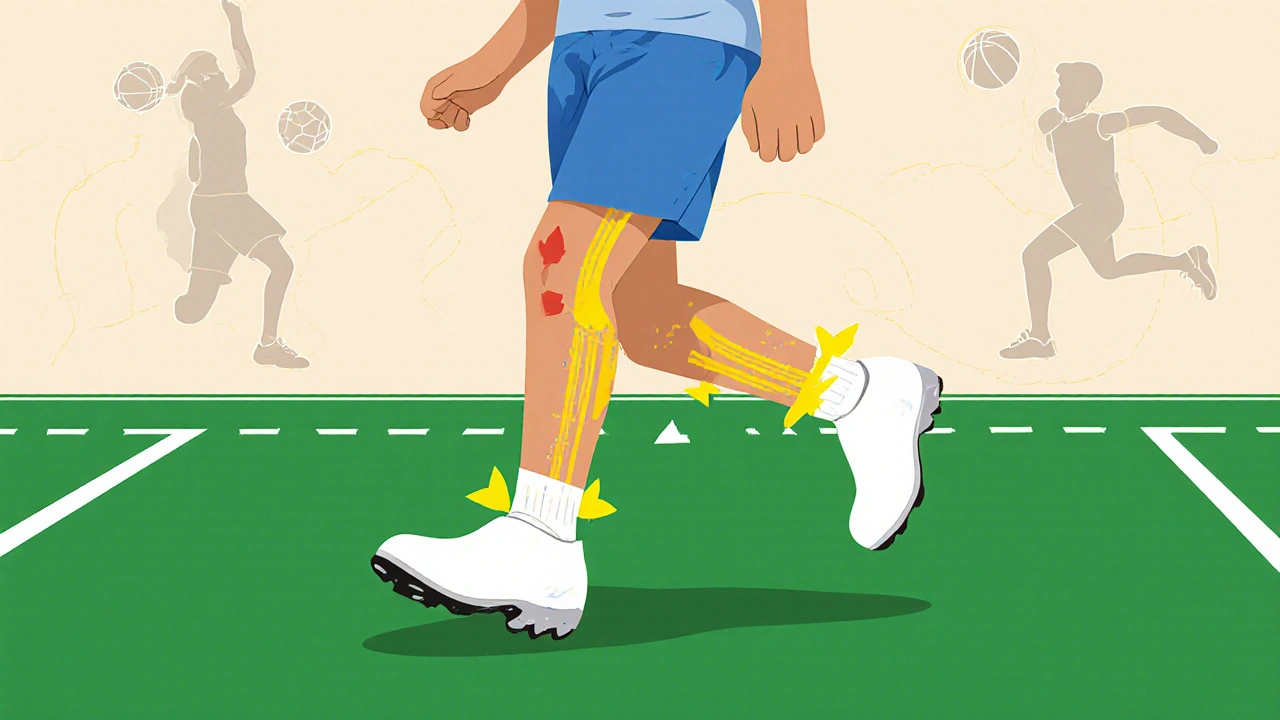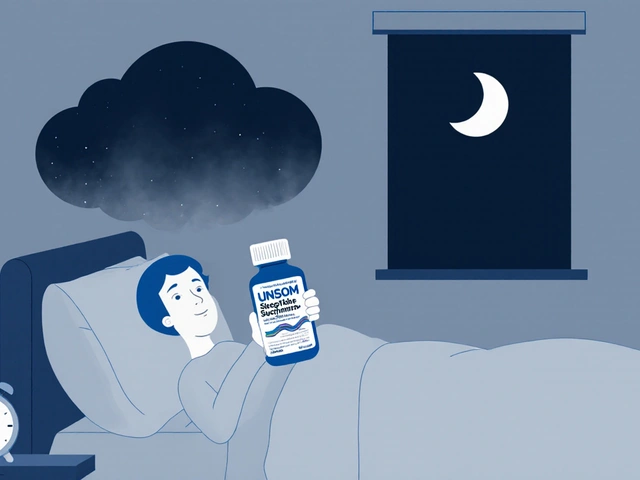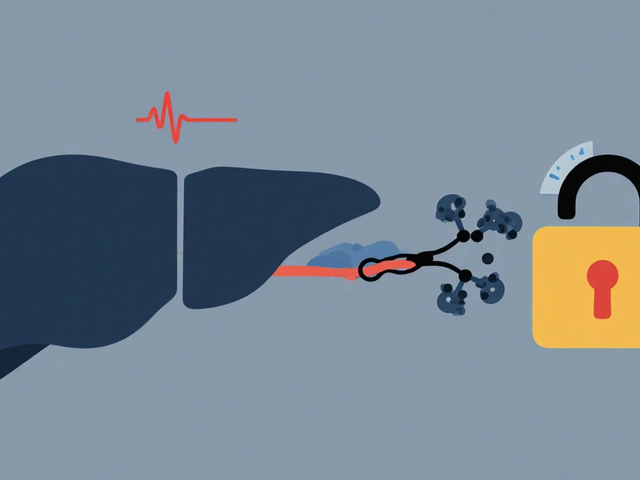Joint damage in kids and teens isn’t something you just grow out of. What starts as a minor ache after soccer practice can turn into chronic pain, arthritis, or even surgery later in life. The good news? Most joint damage in young people is preventable - if you know what to look for and how to act.
Why Kids’ Joints Are More Vulnerable
Children’s bones and joints aren’t just smaller versions of adult ones. Their growth plates - the soft areas near the ends of long bones - are still developing until their late teens. These plates are weaker than the surrounding ligaments and tendons, making them the most likely spot for injury during sports or play. A fall that might give an adult a sprain can cause a growth plate fracture in a 12-year-old. And because kids often push through pain, ignoring early signs makes things worse.Overuse is another big culprit. Think of a 14-year-old pitcher throwing 80 pitches a day, five days a week, year-round. Or a 13-year-old ballet dancer doing the same jumps 200 times in a single practice. Their bodies don’t get enough rest to recover. Studies show that young athletes who specialize in one sport before age 14 are 70% more likely to suffer overuse injuries like tendonitis or stress fractures in their knees, ankles, and elbows.
Signs of Trouble - Don’t Ignore These
Pain isn’t normal, even if your child says, “It’s just sore.” Look for these red flags:- Joint pain that lasts more than a few days after activity
- Limping or avoiding use of a limb
- Swelling, warmth, or redness around a joint
- Clicking, popping, or locking in the knee or elbow
- Complaints of pain at night - especially if it wakes them up
These aren’t signs of being “out of shape.” They’re signs that the joint is under too much stress. A child who stops running because their knee hurts isn’t being lazy - they’re protecting themselves. Listen to them.
Prevention Starts with Movement - But Not Too Much
The key isn’t to stop activity. It’s to move smarter. Kids need movement to build strong bones and muscles, but they need variety too. The American Academy of Pediatrics recommends that young athletes take at least one full day off per week from organized sports and avoid specializing in one sport until after puberty.Encourage multi-sport participation. A kid who plays soccer in the fall, basketball in winter, and swims in spring builds balanced strength. Their hips, knees, and shoulders get used in different ways. This reduces the risk of repetitive strain. One study of 1,200 adolescent athletes found that those who played three or more sports had 50% fewer serious joint injuries than those who focused on just one.
Strength Training - Yes, Really
Many parents think weightlifting is dangerous for kids. That’s outdated. What’s dangerous is lifting heavy weights with bad form. What’s safe - and powerful - is bodyweight training and light resistance with proper technique.Start with exercises that build stability:
- Bodyweight squats - focus on keeping knees aligned over toes
- Glute bridges - strengthens hips and takes pressure off knees
- Planks - builds core control to protect the spine and pelvis
- Step-ups - improves balance and single-leg strength
Do these 2-3 times a week for 15-20 minutes. No heavy barbells needed. The goal isn’t muscle size - it’s joint protection. Strong muscles around the knee, ankle, and shoulder act like natural shock absorbers. A 2023 review in the Journal of Pediatric Orthopaedics found that kids who did regular strength training had 30-40% fewer ACL tears and ankle sprains.

Footwear and Equipment Matter More Than You Think
A pair of worn-out sneakers can be as bad as no shoes at all. Kids’ feet grow fast - check their shoes every 4-6 months. If the heel is collapsed, the tread is smooth, or the shoe bends in the middle instead of at the ball of the foot, it’s time to replace them.For sports like basketball or volleyball, make sure they have proper ankle support. For soccer, cleats should match the playing surface - turf cleats on grass cause more twisting injuries. And never let them play in hand-me-down gear. A helmet that’s too big won’t protect. Shoes that are too tight can misalign the foot, throwing off the whole leg.
Rest Isn’t Optional - It’s Part of Training
Rest isn’t laziness. It’s recovery. Kids need at least 8-10 hours of sleep a night. During deep sleep, their bodies repair cartilage, rebuild tendons, and balance hormones that control inflammation. A 2024 study tracking 800 adolescents showed that those who slept less than 7 hours per night were twice as likely to develop overuse joint injuries.Also, schedule rest days. If your child has two games and two practices in one week, make sure they have at least two full rest days. No swimming, no dance class, no extra running. Let the joints reset.
Watch for Weight and Nutrition
Extra weight puts extra pressure on joints. Every pound of body weight adds 3-4 pounds of force on the knees during walking, and up to 10 pounds during jumping. That’s why overweight teens are at higher risk for knee pain and early osteoarthritis.But it’s not just about cutting sugar. Joints need nutrients:
- Calcium and vitamin D - for bone strength. Milk, yogurt, fortified cereals, and sunlight help.
- Omega-3 fatty acids - reduce inflammation. Found in salmon, walnuts, chia seeds.
- Protein - repairs tissue. Eggs, beans, chicken, tofu.
- Hydration - joints need water to stay lubricated. Kids should drink water before, during, and after activity.
A child who skips breakfast and drinks soda all day isn’t just missing energy - they’re missing the building blocks their joints need to stay healthy.
When to See a Professional
If pain lasts more than two weeks, gets worse with rest, or affects daily activities like walking or climbing stairs, see a pediatric physiotherapist or sports medicine doctor. Don’t wait for an X-ray to show damage. Early intervention - like a custom orthotic, a short break from sports, or a targeted strengthening plan - can stop problems before they become permanent.Physical therapists who work with kids know how to adjust exercises for growing bodies. They can spot muscle imbalances before they cause injury. A simple 30-minute assessment can prevent months of pain.
Real-Life Example: Emma’s Story
Emma, 13, loved basketball. She played year-round, practiced daily, and rarely took a break. By winter, her knees ached constantly. Her parents thought it was growing pains. After six months of pain, she couldn’t jump without crying. An MRI showed early signs of patellar tendinitis and a minor stress reaction in her shin. She was put on a 6-week rehab plan: no basketball, daily glute and quad strengthening, ice after school, and a strict sleep schedule. Three months later, she returned to the court - pain-free. She now plays two sports, rests two days a week, and never skips her warm-up.Emma didn’t need surgery. She didn’t need drugs. She just needed better habits.
What to Do Today
You don’t need a fancy plan. Start with three simple steps:- Check your child’s shoes - are they worn out or too small?
- Ask them: “Do your joints ever hurt after playing?” If yes, write down when and where.
- Replace one extra practice this week with a walk, a bike ride, or a stretch session.
Joint health isn’t about preventing all activity. It’s about making sure movement lasts a lifetime. The habits you help your child build now will protect their knees, hips, and spine into adulthood.
Can joint damage in kids be reversed?
Early-stage joint damage from overuse or poor mechanics can often be reversed with rest, physical therapy, and lifestyle changes. Growth plate injuries, if caught early, usually heal fully. But if damage leads to cartilage wear or bone changes, it may become permanent. The key is acting before the joint structure changes.
Is it safe for teens to lift weights?
Yes, as long as the focus is on technique, not weight. Teens can safely use bodyweight exercises, resistance bands, and light dumbbells under supervision. Avoid max lifts, powerlifting, or Olympic lifts before age 16. Strength training actually protects joints by improving muscle control and stability.
Should kids stop playing sports if they have joint pain?
Not always. Sometimes, modifying activity helps - like switching from running to swimming, or reducing practice time. But if pain is sharp, constant, or wakes them up at night, they need a break. Continuing to play through pain increases the risk of serious injury. A short pause is better than a season-long setback.
How often should kids have a joint check-up?
There’s no standard screening, but if your child is active in sports, consider a check-up every 12-18 months. If they’ve had a previous injury or complain of recurring pain, see a specialist every 6 months. Prevention is cheaper and easier than repair.
Does poor posture cause joint damage?
Yes. Slouching while sitting, walking with feet turned inward, or carrying heavy backpacks on one shoulder can misalign joints over time. This leads to uneven pressure, muscle imbalances, and pain in the knees, hips, or spine. Simple posture corrections - like sitting with feet flat, shoulders back, and head up - can prevent long-term issues.







Premanka Goswami
November 18, 2025 AT 12:58They don't want you to know this, but joint damage is just the tip of the iceberg. The real agenda? Big Pharma and youth sports corporations are colluding to keep kids dependent on braces, painkillers, and surgeries. Why? Because a broken knee at 14 means a lifetime of prescriptions. Look at the stats - they’re manipulated. The real solution? Raw foods, grounding barefoot on soil, and stopping organized sports entirely. They’ve been programming kids to break down since the 90s. Wake up.
Alexis Paredes Gallego
November 19, 2025 AT 15:51Oh wow, another ‘do more stretches’ article from the wellness-industrial complex. Let me guess - next they’ll tell us to ‘drink more water’ and ‘sleep better’ like those are revolutionary ideas? My cousin played soccer 7 days a week since age 8, never stretched, ate fast food, and now he’s a pro athlete. Your ‘prevention’ is just fear-mongering dressed up as science. Kids are tougher than you think. Stop coddling them.
Saket Sharma
November 20, 2025 AT 18:36Overuse injuries are 90% preventable - but only if parents enforce structured recovery protocols. Lack of periodization + early specialization = biomechanical catastrophe. The data is unequivocal: single-sport athletes under 14 exhibit 2.3x higher incidence of tendinopathies. Your child isn’t ‘tough’ - they’re accumulating microtrauma. Fix the system, not the symptom.
Shravan Jain
November 20, 2025 AT 23:17the article is... well written? but i think it misses the point. kids dont need more strength training, they need less pressure. why are we pushing 12 year olds to be athletes? its not about shoes or sleep - its about a culture that equates worth with performance. also, ‘glute bridges’? really? this feels like a corporate wellness pamphlet. and who wrote this? a physiotherapist? or a marketing intern?
Brandon Lowi
November 22, 2025 AT 11:28AMERICA IS BEING DESTROYED BY THIS! We’ve turned our children into disposable machines for college scholarships and Nike ads! They’re not ‘kids’ - they’re revenue streams! And now we’re told to do ‘glute bridges’ like it’s yoga? What about the 10 million kids who can’t afford proper shoes? What about the schools that cut PE to fund football? This isn’t prevention - it’s a Band-Aid on a severed artery! We need systemic change, not exercises!
Joshua Casella
November 24, 2025 AT 10:54I’ve worked with dozens of adolescent athletes over the last 15 years. The most successful ones aren’t the ones who trained the hardest - they’re the ones who listened. The ones who rested when tired. The ones who switched sports when their knees complained. The parents who said ‘no’ to extra practice. This isn’t rocket science. It’s basic respect for the body. Start small. Talk to your kid. Don’t fixate on stats. Fixate on them.
Richard Couron
November 25, 2025 AT 02:37They’re lying to you. The ‘growth plates’ thing? That’s what they told us in 2008 - then they started selling those $200 ‘growth support’ supplements. And now? They want you to believe that ‘bodyweight squats’ will save your kid? Meanwhile, the CDC admits 70% of youth injuries happen during unsupervised play - not organized sports. Who’s really responsible? The schools? The coaches? Or the parents who think ‘more is better’? I’ve seen kids with broken ankles because their dad pushed them to ‘tough it out.’ This isn’t prevention - it’s guilt-tripping.
Bruce Bain
November 25, 2025 AT 07:30My nephew plays soccer. He’s 11. He used to cry after every game. We switched him to swimming twice a week, got him new shoes, and made him sleep 9 hours. No more pain. No drama. Just a happy kid who runs around like normal. Sometimes the answer is simple: rest, eat, move differently.
Jonathan Gabriel
November 26, 2025 AT 02:39So… if a 13-year-old does glute bridges and sleeps 8 hours, she magically avoids all joint damage? What about genetics? What about congenital alignment issues? What about the kid who was born with a hip dysplasia? You’re treating symptoms as if they’re universal causes. This isn’t a guide - it’s a feel-good checklist for anxious parents. Where’s the nuance? Where’s the ‘sometimes, it’s just bad luck’?
Don Angel
November 27, 2025 AT 19:14Just one thing: if your kid says their knee hurts, don’t argue. Don’t tell them to ‘push through it.’ Just stop. For a week. See what happens. That’s it. That’s the whole thing.